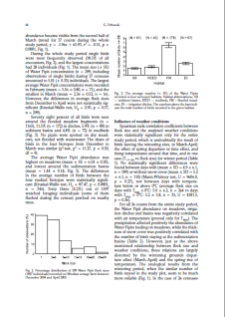
Object
Title: Nest sites of Great Spotted Woodpeckers Dendrocopos major and Middle Spotted Woodpeckers Dendrocopos medius in Near-Natural and Managed Riverine Forests
Creator:
Kosiński, Ziemowit ; Ksit, Paweł ; Winiecki, Aleksander
Date issued/created:
Resource type:
Subtitle:
Charakterystyka miejsc gniazdowania dzięcioła dużego i dzięcioła średniego w lesie łęgowym seminaturalnym i użytkowanym gospodarczo ; Nest-sites characteristics of two woodpeckers’ species
Contributor:
Museum and Institute of Zoology, Polish Academy of Sciences
Publisher:
Museum and Institute of Zoology, Polish Academy of Sciences
Place of publishing:
Description:
Type of object:
Abstract:
The main goals of this study were to determine whether woodpeckers differ in nest-site selection between near-natural old-growth forests protected for ca. 50 years and managed forests. Great Spotted Woodpeckers preferred oaks as nest sites, but Middle Spotted Woodpeckers selected dead trees as well as live ashes and oaks. It was found that the degree of silviculture did not affect the preference for tree species between long-term protected and managed areas in either Dendrocopos species. However, the share of ashes as nesting trees for Middle Spotted Woodpeckers was distinctly smaller in managed stands. In primeval Quercus-Fraxinus-Ulmus riverine forests ashes are thought to have played an important role as a nest-site for this species. In unmanaged forests both woodpeckers nested in trees of a larger diameter, at a nearly twofold higher rate than in managed stands. Nest-height was influenced by tree diameter. However, these relationships varied between the two woodpecker species, in relation both to the type of management and to the tree species, and were the most pronounced in Middle Spotted Woodpeckers nesting in ashes in near-natural stands. The type of management did not affect the placements of nest-holes in relation to tree condition, state of tree stump and condition of the wood in either species. However, in comparison to the near-natural forests, both species excavated holes more frequently than expected in tree-trunks in the managed stands. The results of the present work suggest a convergence of some nest-site characteristics in managed forests.
Relation:
Volume:
Issue:
Start page:
End page:
Detailed Resource Type:
Format:
Resource Identifier:
oai:rcin.org.pl:55560 ; 10.3161/068.041.0108
Source:
MiIZ PAN, call no. P.257 ; MiIZ PAN, call no. P.4568 ; click here to follow the link
Language:
Language of abstract:
Rights:
Rights Reserved - Restricted Access
Terms of use:
Digitizing institution:
Museum and Institute of Zoology of the Polish Academy of Sciences
Original in:
Library of the Museum and Institute of Zoology of the Polish Academy of Sciences
Access:
Object collections:
- Museum and Institute of Zoology PAS > Scientific Journals
- Museum and Institute of Zoology PAS > MIZ PAN Publications > Acta Ornithologica
Last modified:
Aug 8, 2023
In our library since:
Jul 29, 2015
Number of object content downloads / hits:
11
All available object's versions:
https://rcin.org.pl/miiz/publication/75742
Show description in RDF format:
Show description in RDFa format:
Show description in OAI-PMH format:
Objects Similar
Kosiński, Ziemowit Ksit, Paweł
Mazgajski, Tomasz D.
Salvati, Luca Manganaro, Alberto Ranazzi, Lamberto
Domaniewski, Janusz (1891–1954)
Rychlik, Barbara (1952– )
Osiejuk, Tomasz S.
Kosiński, Ziemowit Kempa, Marcin Hybsz, Robert Polska Akademia Nauk. Muzeum i Instytut Zoologii
Kosiński, Ziemowit

 INSTYTUT ARCHEOLOGII I ETNOLOGII POLSKIEJ AKADEMII NAUK
INSTYTUT ARCHEOLOGII I ETNOLOGII POLSKIEJ AKADEMII NAUK
 INSTYTUT BADAŃ LITERACKICH POLSKIEJ AKADEMII NAUK
INSTYTUT BADAŃ LITERACKICH POLSKIEJ AKADEMII NAUK
 INSTYTUT BADAWCZY LEŚNICTWA
INSTYTUT BADAWCZY LEŚNICTWA
 INSTYTUT BIOLOGII DOŚWIADCZALNEJ IM. MARCELEGO NENCKIEGO POLSKIEJ AKADEMII NAUK
INSTYTUT BIOLOGII DOŚWIADCZALNEJ IM. MARCELEGO NENCKIEGO POLSKIEJ AKADEMII NAUK
 INSTYTUT BIOLOGII SSAKÓW POLSKIEJ AKADEMII NAUK
INSTYTUT BIOLOGII SSAKÓW POLSKIEJ AKADEMII NAUK
 INSTYTUT CHEMII FIZYCZNEJ PAN
INSTYTUT CHEMII FIZYCZNEJ PAN
 INSTYTUT CHEMII ORGANICZNEJ PAN
INSTYTUT CHEMII ORGANICZNEJ PAN
 INSTYTUT FILOZOFII I SOCJOLOGII PAN
INSTYTUT FILOZOFII I SOCJOLOGII PAN
 INSTYTUT GEOGRAFII I PRZESTRZENNEGO ZAGOSPODAROWANIA PAN
INSTYTUT GEOGRAFII I PRZESTRZENNEGO ZAGOSPODAROWANIA PAN
 INSTYTUT HISTORII im. TADEUSZA MANTEUFFLA POLSKIEJ AKADEMII NAUK
INSTYTUT HISTORII im. TADEUSZA MANTEUFFLA POLSKIEJ AKADEMII NAUK
 INSTYTUT JĘZYKA POLSKIEGO POLSKIEJ AKADEMII NAUK
INSTYTUT JĘZYKA POLSKIEGO POLSKIEJ AKADEMII NAUK
 INSTYTUT MATEMATYCZNY PAN
INSTYTUT MATEMATYCZNY PAN
 INSTYTUT MEDYCYNY DOŚWIADCZALNEJ I KLINICZNEJ IM.MIROSŁAWA MOSSAKOWSKIEGO POLSKIEJ AKADEMII NAUK
INSTYTUT MEDYCYNY DOŚWIADCZALNEJ I KLINICZNEJ IM.MIROSŁAWA MOSSAKOWSKIEGO POLSKIEJ AKADEMII NAUK
 INSTYTUT PODSTAWOWYCH PROBLEMÓW TECHNIKI PAN
INSTYTUT PODSTAWOWYCH PROBLEMÓW TECHNIKI PAN
 INSTYTUT SLAWISTYKI PAN
INSTYTUT SLAWISTYKI PAN
 SIEĆ BADAWCZA ŁUKASIEWICZ - INSTYTUT TECHNOLOGII MATERIAŁÓW ELEKTRONICZNYCH
SIEĆ BADAWCZA ŁUKASIEWICZ - INSTYTUT TECHNOLOGII MATERIAŁÓW ELEKTRONICZNYCH
 MUZEUM I INSTYTUT ZOOLOGII POLSKIEJ AKADEMII NAUK
MUZEUM I INSTYTUT ZOOLOGII POLSKIEJ AKADEMII NAUK
 INSTYTUT BADAŃ SYSTEMOWYCH PAN
INSTYTUT BADAŃ SYSTEMOWYCH PAN
 INSTYTUT BOTANIKI IM. WŁADYSŁAWA SZAFERA POLSKIEJ AKADEMII NAUK
INSTYTUT BOTANIKI IM. WŁADYSŁAWA SZAFERA POLSKIEJ AKADEMII NAUK
































